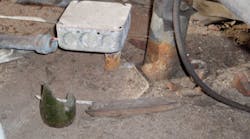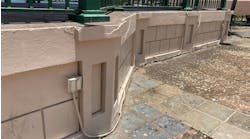How well do you know the Code? Think you can spot violations the original installer either ignored or couldn't identify? Here's your chance to moonlight as an electrical inspector and second-guess someone else's work from the safety of your living room or office. Joe Tedesco, who has a knack for finding shoddy electrical work, did the dirty work and found this mess. Now it's your turn to identify the violation.
Find the Answer
Shawn Hutchinson, a journeyman wireman with IBEW Local Union 640 in Phoenix, submitted this response to the photo in the June issue. “This fitting won't prevent moisture from entering or accumulating within the box, conduit body, or fitting as noted in 314.15(A),” he wrote. “In addition, conductors must be protected from abrasion as noted in 314.17. And if using electrical metallic tubing (EMT) as the equipment grounding conductor, the fitting must be made tight as noted in 250.120(A).”
Robert Weber, P.E., vice president of engineering, S.L. King & Associates, Inc., Atlanta, submitted this comment. “This electrical box is not suitable for installation in a wet location,” he wrote. “In addition, note the non-continuity of conduit, lack of proper support, exposed wiring, and lack of bushing. The broken bottle can also be cited as an OSHA violation.”
In addition to noting a violation of 314.15(A), Greg Sparks, electrical engineer, Portland International Airport, Portland, Ore., cited a violation of 358.10(B), which states “Ferrous or nonferrous EMT, elbows, couplings, and fittings shall be permitted to be installed in concrete, in direct contact with the earth, or in areas subject to severe corrosion influences where protected by corrosion protection and judged suitable for the condition.”



